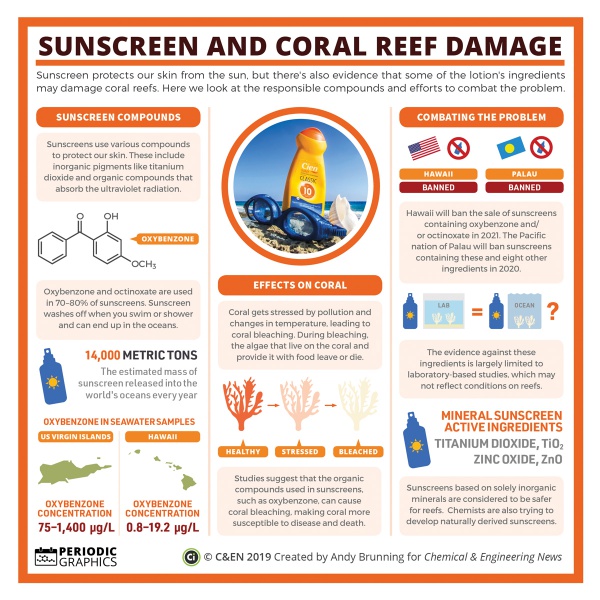Oxybenzone
Oxybenzone is a phenol that may be oxidized, creating a stressful environment for coral reefs.
General Information
IUPAC name: 2-hydroxy-4-methoxyphenyl)-phenylmethanone
Only 4% of ozybenzone in sunscreen is absorbed into the skin, the remaining 96% is washed off and enters various water ways (Dinardo, Joseph and Downs, A Craig 2018).
As a sunscreen additive, oxybenzone is less effective at protecting against UV exposure than avobenzone, titanium dioxide, and/ or zinc oxide (Dinardo, Joseph and Downs, A Craig 2018).
Adverse Effects of Oxybenzone
Several studies have reported that oxybenzone has adverse effects on reproduction and development of algae, the freshwater flea, and plarian (Kim, Sujin and Choi, Kyungho 2014). Oxybenzone is a photoxicant, genotoxicant, and a skeletal endocrine disruptor in coral. Oxybenzone has also been found in the tissue of many fish that humans consume (ex. white fish, perch, and rainbow trout). Oxybenzone inhibits reproduction of coral and fish via embryo toxicity and/or causes male fish to be feminized (DiNardo, Joseph and Downs, A Craig 2018). There is not much information on the long term ecological effects of oxybenzone in our freshwater systems, so further investigation is warranted.
Oxybenzone is also one of the top three most frequent allergens in sunscreens (DiNardo, Joseph and Downs, A Craig 2018).
Physical Properties
Names:
- 2-Hydroxy-4-methoxybenzophenone
- Oxybenzone
- Benzophenone-3 (BZ-3) <--trade naming, see other below
- Eusolex 4360
- Escalol 567
Molecular weight: 228.24 g/mol
Boiling point: 115°C.
Melting point: 65.5°C.
Density: 1.32 g/mL.
pKa: 7.1.
UV max: 288 and 326 nm.
Described as an off-white or light yellow powder.
Other--> Benzophenone-n
Chemical Oxidation
Chlorination of Oxybenzone
Background Information
Background Information for Oxybenzone
Research Paper
References
Sunscreens Cause Coral Bleaching by Promoting Viral Infections

